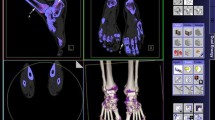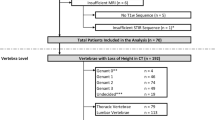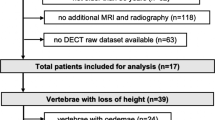Abstract
Purpose of Review
This review article aims to summarize the available literature regarding the utility of Dual-Energy CT (DECT) in spine imaging.
Recent Findings
DECT using virtual non-calcium images, virtual monoenergetic images, and material decomposition techniques have shown promise in bone marrow edema visualization associated with vertebral fractures, metallic artifact reduction related to spinal hardware, axial monosodium urate deposit detection, bone marrow composition evaluation, and bone marrow lesion identification. In our experience, DECT may also be an assuring technique in evaluation of disc degeneration, and disc herniation.
Summary
DECT imaging of the spine has numerous clinical applications, potential advantages over single-energy CT and other imaging modalities, and future promising avenues.









Similar content being viewed by others
References
Johnson TR, Krauss B, Sedlmair M, Grasruck M, Bruder H, Morhard D, et al. Material differentiation by dual energy CT: initial experience. Eur Radiol. 2007;17(6):1510–7. doi:10.1007/s00330-006-0517-6.
Yu L, Christner JA, Leng S, Wang J, Fletcher JG, McCollough CH. Virtual monochromatic imaging in dual-source dual-energy CT: radiation dose and image quality. Med Phys. 2011;38(12):6371–9. doi:10.1118/1.3658568.
Bamberg F, Dierks A, Nikolaou K, Reiser MF, Becker CR, Johnson TR. Metal artifact reduction by dual energy computed tomography using monoenergetic extrapolation. Eur Radiol. 2011;21(7):1424–9. doi:10.1007/s00330-011-2062-1.
Lee YH, Park KK, Song HT, Kim S, Suh JS. Metal artefact reduction in gemstone spectral imaging dual-energy CT with and without metal artefact reduction software. Eur Radiol. 2012;22(6):1331–40. doi:10.1007/s00330-011-2370-5.
Foley WD, Shuman WP, Siegel MJ, Sahani DV, Boll DT, Bolus DN, et al. White Paper of the Society of Computed Body Tomography and Magnetic Resonance on Dual-Energy CT, Part 2: Radiation Dose and Iodine Sensitivity. J Comput Assist Tomogr. 2016;40(6):846–50. doi:10.1097/RCT.0000000000000539.
De Cecco CN, Schoepf UJ, Steinbach L, Boll DT, Foley WD, Kaza RK, et al. White Paper of the Society of Computed Body Tomography and Magnetic Resonance on Dual-Energy CT, Part 3: Vascular, Cardiac, Pulmonary, and Musculoskeletal Applications. J Comput Assist Tomogr. 2017;41(1):1–7. doi:10.1097/RCT.0000000000000538.
De Cecco CN, Boll DT, Bolus DN, Foley WD, Kaza RK, Morgan DE, et al. White Paper of the Society of Computed Body Tomography and Magnetic Resonance on Dual-Energy CT, Part 4: Abdominal and Pelvic Applications. J Comput Assist Tomogr. 2017;41(1):8–14. doi:10.1097/RCT.0000000000000546.
Siegel MJ, Kaza RK, Bolus DN, Boll DT, Rofsky NM, De Cecco CN, et al. White Paper of the Society of Computed Body Tomography and Magnetic Resonance on Dual-Energy CT, Part 1: Technology and Terminology. J Comput Assist Tomogr. 2016;40(6):841–5. doi:10.1097/RCT.0000000000000531.
Cummings SR, Melton LJ. Epidemiology and outcomes of osteoporotic fractures. Lancet. 2002;359(9319):1761–7. doi:10.1016/S0140-6736(02)08657-9.
Melton LJ, Atkinson EJ, Cooper C, O’Fallon WM, Riggs BL. Vertebral fractures predict subsequent fractures. Osteoporos Int. 1999;10(3):214–21.
Cooper C, Atkinson EJ, Jacobsen SJ, O’Fallon WM, Melton LJ. Population-based study of survival after osteoporotic fractures. Am J Epidemiol. 1993;137(9):1001–5.
Melton LJ. Adverse outcomes of osteoporotic fractures in the general population. J Bone Miner Res. 2003;18(6):1139–41. doi:10.1359/jbmr.2003.18.6.1139.
Thiryayi WA, Thiryayi SA, Freemont AJ. Histopathological perspective on bone marrow oedema, reactive bone change and haemorrhage. Eur J Radiol. 2008;67(1):62–7. doi:10.1016/j.ejrad.2008.01.056.
Mandalia V, Henson JH. Traumatic bone bruising—a review article. Eur J Radiol. 2008;67(1):54–61. doi:10.1016/j.ejrad.2008.01.060.
Henes FO, Groth M, Kramer H, Schaefer C, Regier M, Derlin T, et al. Detection of occult vertebral fractures by quantitative assessment of bone marrow attenuation values at MDCT. Eur J Radiol. 2014;83(1):167–72. doi:10.1016/j.ejrad.2013.09.015.
• Wang CK, Tsai JM, Chuang MT, Wang MT, Huang KY, Lin RM. Bone marrow edema in vertebral compression fractures: detection with dual-energy CT. Radiology. 2013;269(2):525–33. doi:10.1148/radiol.13122577. In this prospective study, DECT with virtual noncalcium images was shown to be sensitive, specific, and accurate at depicting bone marrow edema using MR as a reference, especially in mildly to moderately collapsed vertebral bodies.
Na D, Hong SJ, Yoon MA, Ahn KS, Kang CH, Kim BH, et al. Spinal bone bruise: can computed tomography (CT) enable accurate diagnosis? Acad Radiol. 2016;23(11):1376–83. doi:10.1016/j.acra.2016.06.006.
• Karaca L, Yuceler Z, Kantarci M, Çakır M, Sade R, Calıkoglu C et al. The feasibility of dual-energy CT in differentiation of vertebral compression fractures. Br J Radiol. 2016;89(1057):20150300. doi:10.1259/bjr.20150300. Prospective study confirming DECT VNC images as being accurate in demonstrating acute vertebral fractures compared to MR.
• Bierry G, Venkatasamy A, Kremer S, Dosch JC, Dietemann JL. Dual-energy CT in vertebral compression fractures: performance of visual and quantitative analysis for bone marrow edema demonstration with comparison to MRI. Skeletal Radiol. 2014;43(4):485–92. doi:10.1007/s00256-013-1812-3. DECT was shown to have good psychometric properties in identifying BME compared to MR, on both quantitative and qualitative assessment.
• Petritsch B, Kosmala A, Weng AM, Krauss B, Heidemeier A, Wagner R et al. Vertebral compression fractures: third-generation dual-energy CT for detection of bone marrow edema at visual and quantitative analyses. Radiology. 2017:162165. doi:10.1148/radiol.2017162165. Prospective study evaluating a third-generation DECT scanner, confirming overall good diagnostic properties of VNCa images on both visual and quantitative analyses for identification of BME, with MR as the reference standard.
• Kaup M, Wichmann JL, Scholtz JE, Beeres M, Kromen W, Albrecht MH et al. Dual-Energy CT-based Display of Bone Marrow Edema in Osteoporotic Vertebral Compression Fractures: Impact on Diagnostic Accuracy of Radiologists with Varying Levels of Experience in Correlation to MR Imaging. Radiology. 2016;280(2):510–9. doi:10.1148/radiol.2016150472. DECT VNCa images were demonstrated to improved diagnosic performance of radiologists with varying levels of experience (1-8 years) in identifying recent vertebral fractures compared to conventional CT, using MR as a reference.
Griffith JF, Yeung DK, Ma HT, Leung JC, Kwok TC, Leung PC. Bone marrow fat content in the elderly: a reversal of sex difference seen in younger subjects. J Magn Reson Imaging. 2012;36(1):225–30. doi:10.1002/jmri.23619.
Li X, Kuo D, Schafer AL, Porzig A, Link TM, Black D, et al. Quantification of vertebral bone marrow fat content using 3 Tesla MR spectroscopy: reproducibility, vertebral variation, and applications in osteoporosis. J Magn Reson Imaging. 2011;33(4):974–9. doi:10.1002/jmri.22489.
Zhu Y, Pandya BJ, Choi HK. Prevalence of gout and hyperuricemia in the US general population: the National Health and Nutrition Examination Survey 2007-2008. Arthritis Rheum. 2011;63(10):3136–41. doi:10.1002/art.30520.
Swan A, Amer H, Dieppe P. The value of synovial fluid assays in the diagnosis of joint disease: a literature survey. Ann Rheum Dis. 2002;61(6):493–8.
Schlesinger N, Baker DG, Schumacher HR. Serum urate during bouts of acute gouty arthritis. J Rheumatol. 1997;24(11):2265–6.
Konatalapalli RM, Demarco PJ, Jelinek JS, Murphey M, Gibson M, Jennings B, et al. Gout in the axial skeleton. J Rheumatol. 2009;36(3):609–13. doi:10.3899/jrheum.080374.
• Toprover M, Krasnokutsky S, Pillinger MH. Gout in the spine: imaging, diagnosis, and outcomes. Curr Rheumatol Rep. 2015;17(12):70. doi:10.1007/s11926-015-0547-7. Interesting review of 131 previously reported cases of spinal involvement in gout.
Saketkoo LA, Robertson HJ, Dyer HR, Virk ZU, Ferreyro HR, Espinoza LR. Axial gouty arthropathy. Am J Med Sci. 2009;338(2):140–6. doi:10.1097/MAJ.0b013e3181a3dc14.
Draganescu M, Leventhal LJ. Spinal gout: case report and review of the literature. J Clin Rheumatol. 2004;10(2):74–9. doi:10.1097/01.rhu.0000120898.82192.f4.
Tran A, Prentice D, Chan M. Tophaceous gout of the odontoid process causing glossopharyngeal, vagus, and hypoglossal nerve palsies. Int J Rheum Dis. 2011;14(1):105–8. doi:10.1111/j.1756-185X.2010.01565.x.
Ogdie A, Taylor WJ, Weatherall M, Fransen J, Jansen TL, Neogi T, et al. Imaging modalities for the classification of gout: systematic literature review and meta-analysis. Ann Rheum Dis. 2015;74(10):1868–74. doi:10.1136/annrheumdis-2014-205431.
Bongartz T, Glazebrook KN, Kavros SJ, Murthy NS, Merry SP, Franz WB, et al. Dual-energy CT for the diagnosis of gout: an accuracy and diagnostic yield study. Ann Rheum Dis. 2015;74(6):1072–7. doi:10.1136/annrheumdis-2013-205095.
Glazebrook KN, Kakar S, Ida CM, Laurini JA, Moder KG, Leng S. False-negative dual-energy computed tomography in a patient with acute gout. J Clin Rheumatol. 2012;18(3):138–41. doi:10.1097/RHU.0b013e318253aa5e.
Choi HK, Burns LC, Shojania K, Koenig N, Reid G, Abufayyah M, et al. Dual energy CT in gout: a prospective validation study. Ann Rheum Dis. 2012;71(9):1466–71. doi:10.1136/annrheumdis-2011-200976.
Bacani AK, McCollough CH, Glazebrook KN, Bond JR, Michet CJ, Milks J, et al. Dual energy computed tomography for quantification of tissue urate deposits in tophaceous gout: help from modern physics in the management of an ancient disease. Rheumatol Int. 2012;32(1):235–9. doi:10.1007/s00296-009-1295-7.
Parikh P, Butendieck R, Kransdorf M, Calamia K. Detection of lumbar facet joint gouty arthritis using dual-energy computed tomography. J Rheumatol. 2010;37(10):2190–1. doi:10.3899/jrheum.100492.
• Carr A, Doyle AJ, Dalbeth N, Aati O, McQueen FM. Dual-Energy CT of Urate Deposits in Costal Cartilage and Intervertebral Disks of Patients With Tophaceous Gout and Age-Matched Controls. AJR Am J Roentgenol. 2016;206(5):1063–7. doi:10.2214/AJR.15.15356. Comparative study evaluating MSU deposition on DECT of the abdomen of 20 patients with tophaceous gout, and 10 age- and sex-matched control subjects. Similar degrees of MSU deposition were found in both groups, mainly within the costal cartilages and intervertebral discs, possibly not indicating a disease-specific finding.
Barrett JF, Keat N. Artifacts in CT: recognition and avoidance. Radiographics. 2004;24(6):1679–91. doi:10.1148/rg.246045065.
Lee MJ, Kim S, Lee SA, Song HT, Huh YM, Kim DH, et al. Overcoming artifacts from metallic orthopedic implants at high-field-strength MR imaging and multi-detector CT. Radiographics. 2007;27(3):791–803. doi:10.1148/rg.273065087.
Knott PT, Mardjetko SM, Kim RH, Cotter TM, Dunn MM, Patel ST, et al. A comparison of magnetic and radiographic imaging artifact after using three types of metal rods: stainless steel, titanium, and vitallium. Spine J. 2010;10(9):789–94. doi:10.1016/j.spinee.2010.06.006.
• Guggenberger R, Winklhofer S, Osterhoff G, Wanner GA, Fortunati M, Andreisek G et al. Metallic artefact reduction with monoenergetic dual-energy CT: systematic ex vivo evaluation of posterior spinal fusion implants from various vendors and different spine levels. Eur Radiol. 2012;22(11):2357–64. doi:10.1007/s00330-012-2501-7. A comparison between single-energy CT and DECT with monoenergetic post processing was performed to assess for artefact reduction using phantoms of different spinal levels. DECT provides significantly better image quality and less metallic artefacts from posterior spinal fusion implants than single-energy CT.
Müller GM, Lundin B, von Schewelov T, Müller MF, Ekberg O, Månsson S. Evaluation of metal artifacts in clinical MR images of patients with total hip arthroplasty using different metal artifact-reducing sequences. Skelet Radiol. 2015;44(3):353–9. doi:10.1007/s00256-014-2051-y.
Young PM, Berquist TH, Bancroft LW, Peterson JJ. Complications of spinal instrumentation. Radiographics. 2007;27(3):775–89. doi:10.1148/rg.273065055.
Gaines RW. The use of pedicle-screw internal fixation for the operative treatment of spinal disorders. J Bone Joint Surg Am. 2000;82(10):1458–76.
Jutte PC, Castelein RM. Complications of pedicle screws in lumbar and lumbosacral fusions in 105 consecutive primary operations. Eur Spine J. 2002;11(6):594–8. doi:10.1007/s00586-002-0469-8.
Fuchs M, Putzier M, Pumberger M, Hermann KG, Diekhoff T. Acute vertebral fracture after spinal fusion: a case report illustrating the added value of single-source dual-energy computed tomography to magnetic resonance imaging in a patient with spinal Instrumentation. Skelet Radiol. 2016;45(9):1303–6. doi:10.1007/s00256-016-2419-2.
• Grams AE, Sender J, Moritz R, Obert M, Stein M, Oertel M et al. Dual energy CT myelography after lumbar osteosynthesis. Rofo. 2014;186(7):670–4. doi:10.1055/s-0033-1356199. Metal artifact disturbances with conventional myelography were compared with DECT for visualizing the spinal canal and foramina in 30 patients with pedicle screw fixation. DECT had greater visualization and fewer artefacts than conventional myelography.
• Srinivasan A, Hoeffner E, Ibrahim M, Shah GV, LaMarca F, Mukherji SK. Utility of dual-energy CT virtual keV monochromatic series for the assessment of spinal transpedicular hardware-bone interface. AJR Am J Roentgenol. 2013;201(4):878–83. doi:10.2214/AJR.12.9736. DECT without post processing was compared with DECT with monochromatic post processing in the assessment of 92 transpedicular screws. DECT with monochromatic post-processing was found to reduce metallic streak and improve the visualization of the metal-bone interface.
• Zhou C, Zhao YE, Luo S, Shi H, Li L, Zheng L et al. Monoenergetic imaging of dual-energy CT reduces artifacts from implanted metal orthopedic devices in patients with factures. Acad Radiol. 2011;18(10):1252–7. doi:10.1016/j.acra.2011.05.009. In the assessment of 47 patients with orthopedic implants, monoenergetic post-processing of DECT was shown to improve the quality of images compared with DECT without post-processing.
Antonacci MD, Hanson DS, Heggeness MH. Pitfalls in the measurement of bone mineral density by dual energy x-ray absorptiometry. Spine. 1996;21(1):87–91 (Phila Pa 1976).
Bolotin HH, Sievänen H. Inaccuracies inherent in dual-energy X-ray absorptiometry in vivo bone mineral density can seriously mislead diagnostic/prognostic interpretations of patient-specific bone fragility. J Bone Miner Res. 2001;16(5):799–805. doi:10.1359/jbmr.2001.16.5.799.
Bolotin HH. DXA in vivo BMD methodology: an erroneous and misleading research and clinical gauge of bone mineral status, bone fragility, and bone remodelling. Bone. 2007;41(1):138–54. doi:10.1016/j.bone.2007.02.022.
Garner HW, Paturzo MM, Gaudier G, Pickhardt PJ, Wessell DE. Variation in attenuation in L1 trabecular bone at different tube voltages: caution is warranted when screening for osteoporosis with the use of opportunistic CT. AJR Am J Roentgenol. 2017;208(1):165–70. doi:10.2214/AJR.16.16744.
Wesarg S, Kirschner M, Becker M, Erdt M, Kafchitsas K, Khan MF. Dual-energy CT-based assessment of the trabecular bone in vertebrae. Methods Inf Med. 2012;51(5):398–405. doi:10.3414/ME11-02-0034.
• Bredella MA, Daley SM, Kalra MK, Brown JK, Miller KK, Torriani M. Marrow Adipose Tissue Quantification of the Lumbar Spine by Using Dual-Energy CT and Single-Voxel (1)H MR Spectroscopy: A Feasibility Study. Radiology. 2015;277(1):230–5. doi:10.1148/radiol.2015142876. DECT has excellent correlation with 1 H MR spectroscopy, as standard reference, in estimation of marrow adipose tissue and bone mineral density. Therefore, DECT was found to be superior in BMD assessment compared to CT specially if there is high content of marrow adipose tissue.
• Arentsen L, Yagi M, Takahashi Y, Bolan PJ, White M, Yee D et al. Validation of marrow fat assessment using noninvasive imaging with histologic examination of human bone samples. Bone. 2015;72:118–22. doi:10.1016/j.bone.2014.11.002. Marrow fat fraction intensities obtained by DECT has a good correlation with histologically assessed bone marrow adipose tissue that could be used to monitor bone health of patients undergoing cytotoxic treatments, especially in oncology population.
• Arentsen L, Hansen KE, Yagi M, Takahashi Y, Shanley R, McArthur A et al. Use of dual-energy computed tomography to measure skeletal-wide marrow composition and cancellous bone mineral density. J Bone Miner Metab. 2016. doi:10.1007/s00774-016-0796-1. DECT has the ability to correct for the bone marrow composition and therefore can accurately assess the volumetric bone mineral density compared to DXA, in which marrow composition cannot be quantified due to superimposing cortical and trabecular bones.
• Zheng S, Dong Y, Miao Y, Liu A, Zhang X, Wang B et al. Differentiation of osteolytic metastases and Schmorl’s nodes in cancer patients using dual-energy CT: advantage of spectral CT imaging. Eur J Radiol. 2014;83(7):1216–21. doi:10.1016/j.ejrad.2014.02.003. DECT shown to be superior in differentiation of osteolytic malignant tumours from benign Schmorl’s nodes of the vertebrae using bone-water and water-bone densities; this reveals the potentials of DECT in differentiating malignant form benign hypodense bony lesions.
• Dong Y, Zheng S, Machida H, Wang B, Liu A, Liu Y et al. Differential diagnosis of osteoblastic metastases from bone islands in patients with lung cancer by single-source dual-energy CT: advantages of spectral CT imaging. Eur J Radiol. 2015;84(5):901–7. doi:10.1016/j.ejrad.2015.01.007. DECT is able to detect and differentiate osteoblastic metastases from bony islands in sclerotic vertebral lesions with good sensitivity and specificity.
Dimopoulos M, Terpos E, Comenzo RL, Tosi P, Beksac M, Sezer O, et al. International myeloma working group consensus statement and guidelines regarding the current role of imaging techniques in the diagnosis and monitoring of multiple Myeloma. Leukemia. 2009;23(9):1545–56. doi:10.1038/leu.2009.89.
• Thomas C, Schabel C, Krauss B, Weisel K, Bongers M, Claussen CD et al. Dual-energy CT: virtual calcium subtraction for assessment of bone marrow involvement of the spine in multiple myeloma. AJR Am J Roentgenol. 2015;204(3):W324–31. doi:10.2214/AJR.14.12613. DECT has better sensitivity, in comparison with SECT, in detection of diffuse bone marrow infiltrations of the spine, particularly in high grade infiltrations.
Vergroesen PP, Kingma I, Emanuel KS, Hoogendoorn RJ, Welting TJ, van Royen BJ, et al. Mechanics and biology in intervertebral disc degeneration: a vicious circle. Osteoarthr Cartil. 2015;23(7):1057–70. doi:10.1016/j.joca.2015.03.028.
Mallinson PI, Coupal TM, McLaughlin PD, Nicolaou S, Munk PL, Ouellette HA. Dual-energy CT for the musculoskeletal system. Radiology. 2016;281(3):690–707. doi:10.1148/radiol.2016151109.
Author information
Authors and Affiliations
Corresponding author
Ethics declarations
Conflict of interest
Dr. Faisal Khosa is the recipient of the Canadian Association of Radiologists/Canadian Radiological Foundation Leadership Scholarship (2017). Mohammed F. Mohammed is a section editor for Current Radiology Reports. Nicolas Murray, Megan Le, Omid Ebrahimzadeh, Ahmed Alharty, Hugue A. Ouellette, and Faisal Khosa each declare no potential conflicts of interest.
Human and Animal Rights and Informed Consent
This article does not contain any studies with human or animal subjects performed by any of the authors.
Additional information
This article is part of the Topical collection on Dual-Energy CT.
Rights and permissions
About this article
Cite this article
Murray, N., Le, M., Ebrahimzadeh, O. et al. Imaging the Spine with Dual-Energy CT. Curr Radiol Rep 5, 44 (2017). https://doi.org/10.1007/s40134-017-0236-6
Published:
DOI: https://doi.org/10.1007/s40134-017-0236-6




